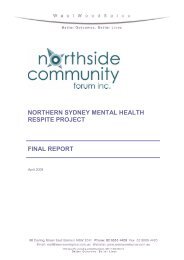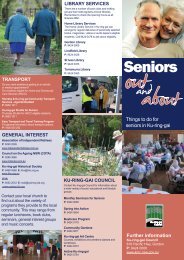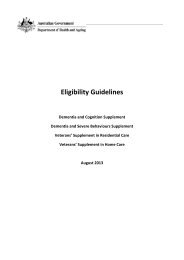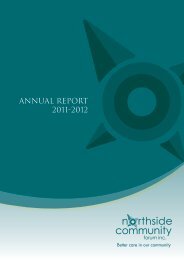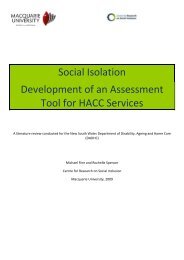Guidelines for field staff to assist people living in ... - Housing NSW
Guidelines for field staff to assist people living in ... - Housing NSW
Guidelines for field staff to assist people living in ... - Housing NSW
Create successful ePaper yourself
Turn your PDF publications into a flip-book with our unique Google optimized e-Paper software.
SECTION 4: The Initial Visit4.1 PurposeThe purpose of conduct<strong>in</strong>g a home visit <strong>to</strong> the person is <strong>to</strong>:1. assess whether the person lives <strong>in</strong> squalor and <strong>to</strong> rate the extent of the squalor2. assess whether the person hoards excessively and/or self-neglects, i.e., doesnot adequately look after his/her bodily requirements and hygiene3. assess the nature and severity of any associated health and lifestyle issues4. make a prelim<strong>in</strong>ary identification of strategies required <strong>to</strong> address the issuesidentified.If a home assessment is not <strong>in</strong>itially possible, <strong>in</strong><strong>for</strong>mation available <strong>to</strong> the agencymay permit identification of the issues <strong>to</strong> be addressed. Case management plansshould <strong>in</strong>clude eventual entry <strong>to</strong> the home, preferably with the consent and<strong>in</strong>volvement of the occupant.The issue of consent <strong>in</strong> relation <strong>to</strong> decision-mak<strong>in</strong>g capacity is complex and is dealtwith <strong>in</strong> more detail <strong>in</strong> Section 8. Field <strong>staff</strong> should also refer <strong>to</strong> their own agency’sconsent procedures.4.2 Approaches <strong>to</strong> engag<strong>in</strong>g the personPeople <strong>liv<strong>in</strong>g</strong> <strong>in</strong> severe domestic squalor vary markedly <strong>in</strong> their nature, personality style,acceptance, cooperation, <strong>in</strong>sight and perception of their circumstances. As aconsequence, there is a need <strong>for</strong> flexibility <strong>in</strong> the approach taken by caseworkers. Some<strong>people</strong> may respond <strong>to</strong> a series of <strong>in</strong>itial, brief, casual meet<strong>in</strong>gs. Others may be morelikely <strong>to</strong> respond <strong>to</strong> a visit by someone perceived <strong>to</strong> be <strong>in</strong> authority, such as a fire officeror the Police. However, cultural sensitivity and appropriateness is important here, assome <strong>people</strong> may feel uncom<strong>for</strong>table with authority figures, which may <strong>in</strong>tensify feel<strong>in</strong>gsof fear and suspicion.Generally, the person is more likely <strong>to</strong> be successfully engaged if an <strong>in</strong>terest is shown <strong>in</strong>them and their particular reason <strong>for</strong> need<strong>in</strong>g help. If the person agrees <strong>to</strong> accept help,the likelihood of achiev<strong>in</strong>g significant change and improv<strong>in</strong>g conditions <strong>for</strong> the <strong>in</strong>dividualand others is considerably greater.Options that could be considered <strong>in</strong>clude:• If the person is <strong>to</strong>o fearful <strong>to</strong> open the door, try leav<strong>in</strong>g a note <strong>in</strong> the mailbox orunder the door, ask<strong>in</strong>g them <strong>to</strong> make contact. Keep<strong>in</strong>g privacy concerns <strong>in</strong> m<strong>in</strong>d,discrete enquiries with neighbours might be of <strong>assist</strong>ance.• Repeat visits by a key worker. Sometimes call<strong>in</strong>g after hours, vary<strong>in</strong>g the hours orvisit<strong>in</strong>g on several occasions may <strong>assist</strong> <strong>to</strong> engage the person.• If the person is of Aborig<strong>in</strong>al or Torres Strait Islander or CALD background,arrang<strong>in</strong>g <strong>to</strong> visit with a worker from the particular background or with anaccredited <strong>in</strong>terpreter may be appropriate. Check with the client as <strong>to</strong> theirpreference and consent prior <strong>to</strong> mak<strong>in</strong>g any arrangements.10




